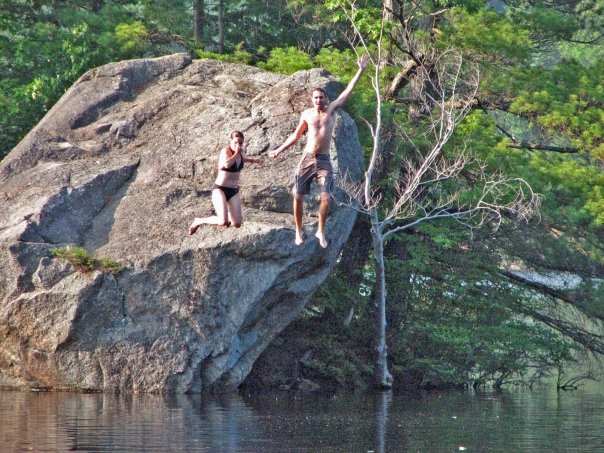
New England is full of glacial erratics: rocks which were transported and dropped by glaciers and which have a different lithology from the rocks upon which they have been deposited. Often, erratic rocks have an angular shape because they were broken off of bedrock by glaciers and have not yet had time to be weathered and rounded by water, wind, and other erosional forces. Glacial erratics can range in size from very small pebbles to very large boulders, but usually it is the boulders which are noticed since these stand out in the landscape and are not easily transported away.
I remember becoming interested in geology as a child when I began noticing large boulders in the middle of fields and the forest around my native New Hampshire. I asked my science teacher about these boulders, and he told me they were called glacial erratics and taught me a little about ice ages. Most of the erratic boulders seen throughout New England today were deposited during the last ice age, which reached a maximum around ~22,000 years ago and which ended ~10,000 years ago.
My favorite glacial erratic, which is shown in this week’s geology picture, sits on a small island in front of my parents’ lakeside cabin on Franklin Pierce Lake in New Hampshire. My parents purchased the cabin about 5 1/2 years ago, and although I had long moved away from home when they bought the cabin, I quickly fell in love with it (and its erratic island!) and try to visit regularly. Every year, my husband and I spend at least a couple of weeks at the cabin. Back in May, the cabin served as a geologist lair when my fellow geoblogger Dana Hunter visited for a few days. If you are brave, you can swim or kayak to the little island from my parents’ cabin and jump off the erratic.

Does anyone else have a favorite glacial erratic to share?

I live on a kame. There is a rock in my hay field that sticks up enough to catch the mower. I put my son on the task of digging it out enough for me to pull it out with the tractor. He was waist deep in the hole and had not come to the edge-we filled it in and put in a flag to save the mower anymore grief.
LikeLike
Pass every morning on way to work, Strangford Lough, Northern Ireland
http://maps.google.co.uk/?ll=54.51889,-5.550842&spn=0.000199,0.153637&t=h&z=13&layer=c&cbll=54.518809,-5.55077&panoid=2h6tLVSkIdDWGOeKoqIogQ&cbp=12,300.82,,0,-7.03
LikeLike
I’ll just link to Dana’s post; this is my favorite photo of the site, though I’ll have to post some of my own photos and discussion sometime. (The photo will get mush bigger if you click it, and if you do so, you can see in my face how incredibly exhausted I was that afternoon, though pleased to have seen so much terrific geology over the previous 3 days.) http://freethoughtblogs.com/entequilaesverdad/2012/07/10/im-back-feeling-a-bit-erratic/
LikeLike
Loving all these comments about people’s favorite glacial erratics. Keep them coming!
LikeLike
On Cannock Chase, Staffordshire, England a glacial erratic boulder has even been mounted on a plinth as a visitor attraction! https://picasaweb.google.com/lh/photo/PLPLqnF5qelsY6L1BXUtD9MTjNZETYmyPJy0liipFm0?feat=directlink
LikeLike
I hope you don’t think I’m trying to win a game of “my erratic’s bigger than yours”, but I live in Calgary, close to the Big Rock at Okotoks: http://en.wikipedia.org/wiki/Big_Rock_(glacial_erratic), which is supposedly the world’s biggest. However, I’m not sure it’s my favorite. Calgary sits plunk in the middle of the Foothills Erratics Train (http://www3.telus.net/lejgeology/etrain/htmls/What%20is%20an%20et.htm), so I have lots to choose from, dozens of which are a short walk or bike ride from my house. This one, which the city accommodated with a little park when suburbia expanded around it, might be one of my favorites: http://goo.gl/maps/8FUO5
LikeLike
Thank you for sharing your interest and passion for Geology! I love it! Lisa in Denver
LikeLike
Union Rock in Lynn Woods (Lynn, Massachusetts). Running right down the center is an igneous contact–a chilled margin between two granites. It is just down the path from Dungeon Rock, which is notorious for squishing a pirate.
LikeLike